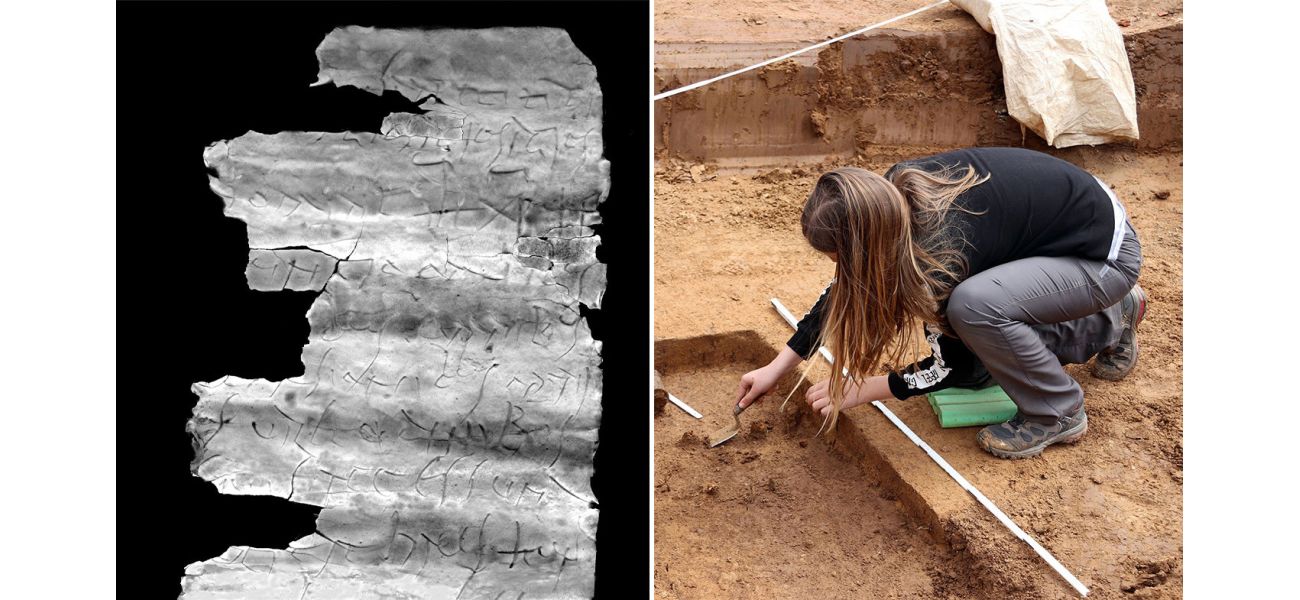Ancient silver relic found in Germany may change the way we understand Christian history in Europe.
A small object, only 3.6 cm long, was discovered in a Roman grave near Frankfurt in 2018.
December 21st 2024.

Experts have recently revealed that a small, silver amulet that was discovered in Germany has the potential to revolutionize our understanding of the early spread of Christianity under the Roman Empire. This remarkable artefact, measuring only 3.6 centimetres in length, was unearthed in 2018 from a 3rd-century Roman grave located just outside Frankfurt. It was found on the remains of a man who was buried in the cemetery of Nida, a significant site in the state of Hesse, Germany.
The amulet, alongside other items such as an incense burner and a clay jug, was discovered under the chin of the skeleton. This amulet, also known as a phylactery, is believed to have been worn on a ribbon around the man's neck for spiritual protection. However, it wasn't until now that researchers were able to examine the thin silver foil that was found inside the amulet.
The team at the Archaeological Museum Frankfurt had to wait until 2019 to conduct microscopic examinations and X-rays on the silver foil due to its delicate and fragile nature. It wasn't until 2021, after using CT scanners to analyze the foil, that researchers were able to decipher the words engraved on it. This breakthrough discovery has astounded experts and has provided valuable insight into the earliest evidence of Christianity in Europe north of the Alps.
The foil contains 18 lines of Latin text that repeatedly reference Jesus and St. Titus, a disciple and confidant of St. Paul the Apostle. This is significant as the grave in which the amulet was found dates back to the 3rd century, making it the earliest evidence of Christianity in this region. Previously, all discoveries of Christianity in this area were from at least 50 years later.
At the time of the burial, Christianity was still considered a risky and unpopular sect. However, the fact that the man was buried with this amulet suggests that he was a devoted Christian who wanted to take his faith with him to the afterlife. The text on the amulet, now known as the "Frankfurt Silver Inscription," was deciphered by archaeologist and Latin expert Professor Markus Scholz from Frankfurt's Goethe University. Scholz worked tirelessly with other experts to decipher the text, which proved to be a challenging and lengthy process.
The fact that the text was entirely in Latin was unexpected, as it was common for inscriptions on amulets to be in Greek or Hebrew during this time period. After translating the text into English, it reads as a prayer and declaration of faith in Jesus Christ, the Son of God. There is no mention of any other religious beliefs, which is unusual for this time period.
Experts believe that this discovery would not have been possible without modern technology. The silver foil was rolled up and creased, making it impossible to decipher the text without the use of CT scanners and advanced imaging technology. This groundbreaking find has provided researchers with a better understanding of the early spread of Christianity in Europe and has challenged previous beliefs about the history of the religion in this region.
The amulet, alongside other items such as an incense burner and a clay jug, was discovered under the chin of the skeleton. This amulet, also known as a phylactery, is believed to have been worn on a ribbon around the man's neck for spiritual protection. However, it wasn't until now that researchers were able to examine the thin silver foil that was found inside the amulet.
The team at the Archaeological Museum Frankfurt had to wait until 2019 to conduct microscopic examinations and X-rays on the silver foil due to its delicate and fragile nature. It wasn't until 2021, after using CT scanners to analyze the foil, that researchers were able to decipher the words engraved on it. This breakthrough discovery has astounded experts and has provided valuable insight into the earliest evidence of Christianity in Europe north of the Alps.
The foil contains 18 lines of Latin text that repeatedly reference Jesus and St. Titus, a disciple and confidant of St. Paul the Apostle. This is significant as the grave in which the amulet was found dates back to the 3rd century, making it the earliest evidence of Christianity in this region. Previously, all discoveries of Christianity in this area were from at least 50 years later.
At the time of the burial, Christianity was still considered a risky and unpopular sect. However, the fact that the man was buried with this amulet suggests that he was a devoted Christian who wanted to take his faith with him to the afterlife. The text on the amulet, now known as the "Frankfurt Silver Inscription," was deciphered by archaeologist and Latin expert Professor Markus Scholz from Frankfurt's Goethe University. Scholz worked tirelessly with other experts to decipher the text, which proved to be a challenging and lengthy process.
The fact that the text was entirely in Latin was unexpected, as it was common for inscriptions on amulets to be in Greek or Hebrew during this time period. After translating the text into English, it reads as a prayer and declaration of faith in Jesus Christ, the Son of God. There is no mention of any other religious beliefs, which is unusual for this time period.
Experts believe that this discovery would not have been possible without modern technology. The silver foil was rolled up and creased, making it impossible to decipher the text without the use of CT scanners and advanced imaging technology. This groundbreaking find has provided researchers with a better understanding of the early spread of Christianity in Europe and has challenged previous beliefs about the history of the religion in this region.
[This article has been trending online recently and has been generated with AI. Your feed is customized.]
[Generative AI is experimental.]
0
0
Submit Comment





